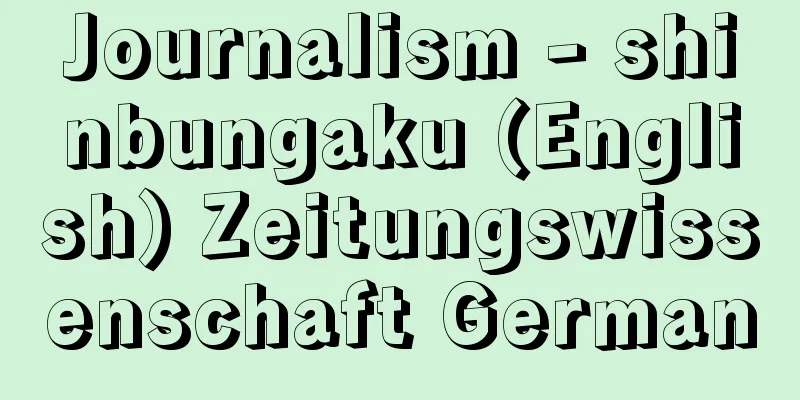Journalism - shinbungaku (English) Zeitungswissenschaft German

|
In the narrow sense, it is a field of study that deals with the social transmission of reports and commentary on current events through periodical printed publications such as newspapers, but in the broad sense, it is synonymous with the field of study (Publizistikwissenschaft [German]) that deals with the social transmission of information through a wide range of mass media, including not only newspapers but also broadcasting, magazines, and movies. Today, the latter is more common. In that sense, it is similar to mass communication studies, which in a broad sense deals with the general social transmission of information through mass media, but there is a slight difference in that while journalism is more focused on the sender's side, mass communication studies is more focused on the receiver's side. Journalism in the narrow sense arose in the West in the late 19th century to the early 20th century, when newspapers had reached a certain stage of popularity and development, and their social influence had begun to grow stronger and more complex. The main trends were (1) cultural scientific research on the nature of the relationship between newspapers and society (Germany), (2) sociological research on the relationship between newspapers and public opinion/social consciousness (France, USA), (3) practical research on how to realize the ideal newspaper (USA), and (4) socialist research that defines newspapers as a means of Communist Party incitement and propaganda (former Soviet Union, China), among which (1), (3), and (4) were the main trends. In the 20th century, new mass media such as movies, radio, and television appeared and began to have a major impact. In light of the development of media other than newspapers, after World War II, mass communication studies arose in the USA, following the lineage of (2), and under its influence, journalism changed from a narrow to a broader sense, and journalism as a social science began to be pursued. In Japan, the narrow definition of journalism, as seen by Hideo Ono and others in the prewar tradition of (1), and Kimpei Matsumoto and Sojinkan Sugimura in the lineage of (3), changed to a broader definition of journalism after the war, and is now treated as essentially synonymous with mass communication studies. [Yoshimi Uchikawa] "The Fundamentals of Newspapers" by Ono Hideo (1947, Tokyodo Publishing)" ▽ "Journalism" by Matsumoto Kumpei (1899, Hakubunkan)" ▽ "Reprint of Recent Newspaper Studies" by Sugimura Sojinkan (1970, Chuo University Press)" ▽ "Introduction to Mass Communication" by Minami Hiroshi (1978, Kobunsha)" ▽ "Journalism" edited by Inaba Michio, Arai Naoyuki, and Katsura Keiichi (1995, Nippon Hyoronsha)" ▽ "Journalism from the Frontline" edited by Amano Katsufumi and Murakami Takato (1996, Gakubunsha)" [References] | |Source: Shogakukan Encyclopedia Nipponica About Encyclopedia Nipponica Information | Legend |
|
狭義には、新聞という定期印刷刊行物による時事に関する報道・論評の社会的伝達現象を対象とする学問をさすが、広義には、新聞だけでなく、放送、雑誌、映画など広くマス・メディアによる情報の社会的伝達現象を対象とする学問(公示学Publizistikwissenschaft〔ドイツ語〕)と同義。今日では後者が一般的である。その意味で、広義ではマス・メディアによる社会的伝達現象一般を対象とするマス・コミュニケーション学に類似しているが、新聞学がどちらかといえば送り手側に寄っているのに対し、マス・コミュニケーション学は、受け手側に寄っている点に若干の相違が認められる。 狭義の新聞学は、新聞の普及発達が一定段階に達し、新聞の社会的影響力が強大複雑化し始めた19世紀末~20世紀初期の欧米でおこった。主要な潮流には、(1)新聞と社会の関係の本質に関する文化科学的研究(ドイツ)、(2)新聞と世論・社会意識の関係に関する社会学的研究(フランス、アメリカ)、(3)あるべき新聞を実現するための実際的研究(アメリカ)、(4)新聞を共産党の扇動・宣伝の手段と規定する社会主義的研究(旧ソ連、中国)などがあり、なかでも(1)(3)(4)が中心となって展開されてきた。20世紀には、映画、ラジオ、テレビなどの新しいマス・メディアが登場し大きな影響を及ぼし始める。こうした新聞以外のメディアの発達を踏まえて、第二次世界大戦後、(2)の系譜を引きつつアメリカでマス・コミュニケーション学が新たにおこり、その影響を受けて、新聞学も狭義から広義に転換し、かつ社会科学としての新聞学が志向されるようになった。日本では、戦前の(1)の流れをくむ小野秀雄らと、(3)の系譜を踏む松本君平、杉村楚人冠(そじんかん)らの狭義新聞学から、戦後は広義新聞学に変化し、事実上マス・コミュニケーション学と同義に扱われている。 [内川芳美] 『小野秀雄著『新聞原論』(1947・東京堂出版)』▽『松本君平著『新聞学』(1899・博文館)』▽『杉村楚人冠著『最近新聞紙学』復刻版(1970・中央大学出版部)』▽『南博著『マス・コミュニケーション入門』(1978・光文社)』▽『稲葉三千男・新井直之・桂敬一編『新聞学』(1995・日本評論社)』▽『天野勝文・村上孝止編『現場からみた新聞学』(1996・学文社)』 [参照項目] | |出典 小学館 日本大百科全書(ニッポニカ)日本大百科全書(ニッポニカ)について 情報 | 凡例 |
<<: Newspaper Articles - Shinbunkiji
Recommend
Nicobium castaneum (English name)
…They like to eat washi paper, causing damage to ...
toga pulla (English spelling) togapulla
...Women also wore togas in the early period, but...
Tokyo Castle (English: Dong-jing)
An earthen fortress in Ning'an County, Heilong...
Okesa persimmon - Okesa persimmon
A regional brand of the Hokuriku, Koshinetsu regio...
Alexandrim
… 【literature】 A term that came into use in early...
Hynobius lichenatus (English spelling) Hynobiuslichenatus
… [Takahiro Matsui]. … *Some of the terminology t...
qāān (English spelling) qaan
…In this empire, local nomadic feudal lords were ...
APDSFS bullet - APDSFS bullet
…The structure of a smoothbore gun is the same as...
Micheli, PA (English spelling) MicheliPA
...This classification criterion is based on the ...
Sekiyama
[1] [noun] ① a mountain with a checkpoint. Also, c...
Kasumigaseki Diplomacy - Kasumigaseki Gaiko
…When the Ministry of Foreign Affairs was founded...
American sycamore - American sycamore
→ Platanus japonica Source : Heibonsha Encyclopedi...
Angkor Wat (English spelling)
A representative Khmer structure (illustration) bu...
Invitation rope - Kanjozuna
...Rope ropes, including shimenawa and yokozuna r...
Electroolfactory Gram
…For example, the electroretinogram records the p...









